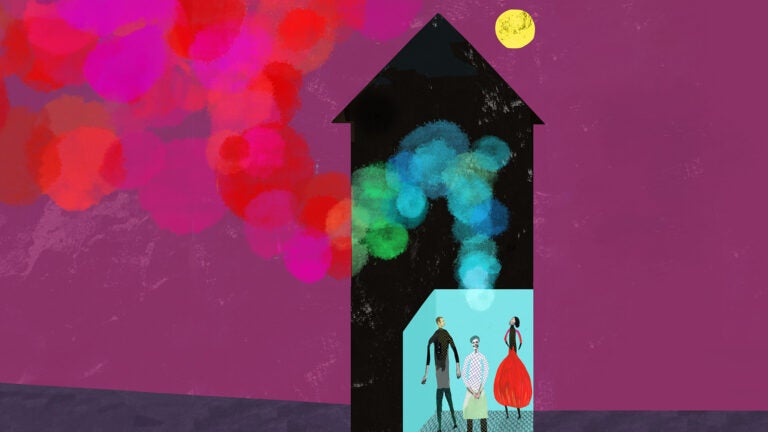
Ancient Technology and New Innovation Could Help Keep Us Cool
 Last September, an epic heat dome settled over the western United States, causing the region’s most severe heat wave on record. In many areas, temperatures soared to triple-digit highs for more than a week. Almost a thousand heat records were broken.
Last September, an epic heat dome settled over the western United States, causing the region’s most severe heat wave on record. In many areas, temperatures soared to triple-digit highs for more than a week. Almost a thousand heat records were broken.
The scorcher is just one example of how heat waves are becoming more intense and longer lasting due to global warming. By 2050, nearly half the world may live in areas where the mercury rises to dangerously high levels for at least a month each year, threatening human health and ways of life.
In warm regions, demand for air conditioning is on the rise. The number of A/C units is estimated to reach 5.6 billionglobally by 2050, up from around 2 billion units today. But populations without the means to obtain and maintain these costly systems will be left out in the cold — or, rather, heat.
Traditional vapor-compressor air conditioners also have considerable environmental costs. They are energy guzzlers, and if fossil fuels are burned to obtain that energy, more planet-warming emissions are released into the air. The toxic refrigerants many of these systems rely on are also potent greenhouse gases that can leak into the atmosphere.
In its current form, A/C is no panacea for beating the climate-change heat. But how else can we keep cool?
The most promising solutions on the horizon leverage technology — some of it cutting-edge, some of it downright ancient.
Building a better A/C
One approach is to reimagine the air conditioner itself, to make it less power hungry and less toxic to the environment. With his company Phononic, Tony Atti ’00 is doing just that.
Atti earned a PhD in chemistry from the USC Dornsife College of Letters, Arts and Sciences where he studied at the USC Dornsife Loker Hydrocarbon Research Insitute, led by renowned chemists G. K. Surya Prakash and the late George Olah, winner of the 1994 Nobel Prize in chemistry.
Atti founded Phononic in 2009 to advance thermoelectric technology, in which cold is generated by moving heat from one side of a thermoelectric chip to another. The technology can use significantly less energy than compressor-based cooling systems and contains no toxic refrigerants. Though the principles underlying thermoelectric technology date back to 1834, Atti spearheaded an effort to make it commercially viable for the 21st century.
Phononic’s thermoelectric HVAC technology will debut this summer in a first-of-its-kind air-cooling system in Europe. Atti explains that the system works by using a building’s established compressor-based system to partially chill the outside air, before Phononic’s technology kicks in to cool it to thermostat level.
Test data show that this hybrid operation reduces a building’s energy consumption by almost 50% and reduces emissions from the building system’s hydrofluorocarbon refrigerant by more than 30%.
Phononic has also developed solutions for localized outdoor cooling. In 2019, the company installed thermoelectric bladeless fans in several popular outdoor locations in Singapore. The fans, which use 50% less energy than industrial bladed fans, create an “air curtain” of cooling over a distinct area that can decrease ambient temperature by up to 50 degrees Fahrenheit and humidity by up to 15%.
Atti plans to bring Phononic-enabled cooling solutions to the United States and elsewhere around the world but notes that moving the needle on compressor-based systems involves time and persistence. “It’s not an easy task,” he says. “Major industries don’t wake up every morning figuring out ways to disrupt themselves.”
Incentivizing power savings
Phononic’s power-saving technology would have come in handy during the West’s September 2022 heat wave, when California’s power grid — overtaxed by air conditioning use — careened toward failure. The state’s grid operator sent texts to consumers warning of blackouts if they didn’t slash their power use. Some voluntarily cut back. The lights stayed on.
But Provost Professor of Economics and Spatial Sciences Matthew Kahn believes that as heat waves intensify, utilities can’t rely solely on volunteerism to avert blackouts. That’s especially true as states such as California phase out fossil fuels and increase reliance on wind and solar energy, supplies of which dwindle when the wind isn’t blowing or the sun has set.
Kahn has been collaborating with USC Viterbi School of Engineering’s Bhaskar Krishnamachari on a plan to boost power conservation at critical times. “We’ve come up with a way to use market forces and personal freedom so that we never have a blackout again,” says Kahn.
The pair champions dynamic pricing programs, in which households that are large users of power are offered a lump sum enrollment payment in exchange for agreeing to higher electric rates when demand surges. “When you face a higher price for consuming resources, this actually nudges you to get lean and mean,” Kahn says.
About two-thirds of homes across the U.S. now have smart electric meters, which communicate a home’s electricity consumption wirelessly to utility companies every few minutes. With the help of linked mobile apps, those enrolled in dynamic pricing could be notified hours in advance of a price surge and plan their usage accordingly.
The anticipation of higher rates may also spur consumers to make power-saving upgrades to keep their homes cooler, such as replacing windows and installing smart thermostats. These devices can be programmed to precool homes before prices rise.
Kahn notes that the top residential power users tend to be high-income households with large homes, so low-income households would not bear the burden of surge pricing.
Unfortunately, political resistance and slow adoption of technology in some cities could be obstacles. “We need smart meters in people’s homes to be able to launch our experiment,” says Kahn.
We’ve come up with a way to use market forces and personal freedom so that we never have a blackout again.”
Reconceiving the built environment

While the latest feats of engineering can encourage more sustainable A/C use, there’s also much we can learn by exploring ancient cooling techniques.
“Long before the advent of air conditioning, people living in hot climates dealt with the challenges of heat, so it is worth looking to their cooling strategies for inspiration,” says Ciruce Movahedi-Lankarani, Farhang Foundation Chair in Iranian Studies and assistant professor of Middle East studies. He notes that certain hallmarks of traditional Middle Eastern architecture serve both ornamental and cooling functions.
Latticework on the exterior of windows enhances air circulation and offers shade from the sun. Wind catchers, which are hollow towers that Movahedi-Lankarani describes as “reverse chimneys,” channel breezes into the home. Internal courtyards, shaded by rooms or walls and often containing lush greenery and splashing fountains, offer a refreshing respite from the heat.
The sandy color of the limestone and mud used to erect traditional buildings reflects heat, and the moisture these materials absorb in humid conditions can later evaporate to provide cooling.
These ancient architectural approaches have largely been abandoned in the modern era. As Middle Eastern cities exploded in size in the 20th century, “many of them essentially transplanted glass, steel and concrete-style structures from Europe, the United States and the Soviet Union,” says Movahedi-Lankarani. “These materials and architectural styles don’t work very well with the local climate. They get hot, essentially.”
As the region warms, “There is some exploration of returning to these more traditional forms of architecture,” he says. But Movahedi-Lankarani also notes that tearing down glass and steel structures to build anew is expensive, not to mention resource-intensive.
Greening the urban desert
The most ancient form of cooling “technology” is perhaps the simplest: the tree. Outdoors, trees provide cover from the sun, and the water vapor they release adds to their cooling effect. When they shade windows and walls, our leafy friends can also cool indoor spaces.
But in cities across the U.S., poor neighborhoods experience on average 25% less tree cover than wealthy ones. Disadvantaged communities also contain a higher share of concrete and asphalt surfaces that absorb heat and then release it back into the atmosphere. These factors create urban heat islands: tree-poor neighborhoods that are hotter than their greener counterparts.
“If you stand in the middle of an unshaded street on one of these really hot days over 100 degrees Fahrenheit, the temperature might climb up to 130 degrees Fahrenheit due to both the sun’s rays and heat rising from the asphalt,” says John Wilson, director of USC Dornsife’s Spatial Sciences Institute and professor of sociology, civil and environmental engineering, computer science, architecture and preventive medicine. “If you walk to the nearest street tree that has a large, vibrant canopy, then you suddenly find the temperature is 30 degrees Fahrenheit or 40 degrees Fahrenheit less than the temperature above the blacktop.”
Wilson is the project lead of the USC Urban Trees Initiative, a collaboration between USC Dornsife’s Public Exchange and the City of Los Angeles. To reach the city’s goal of increasing the tree canopy by 50% in low-income neighborhoods by 2028, Wilson and a team of USC Dornsife and USC School of Architecture scholars and students are advising the city on the number and type of trees that should be planted, and where to plant them.
Since the initiative’s launch in 2020, the team has completed an inventory of each designated neighborhood’s existing tree canopy, created designs for new plantings and collaborated with community members to determine priority streets for the new trees.
Now, Wilson is developing a shade model using Geographic Information System technology and data from the Los Angeles Region Imagery Acquisition Consortium. The model will project how much shade the proposed tree plantings will cast on streets, sidewalks and buildings to predict the cooling benefits. This will help the city make final decisions about planting configurations, with an eye toward putting shovels in the ground in 2024.
The cold reality
The Urban Trees Initiative highlights the complexities of the planet’s quest for sustainable cooling. To provide relief for the largest number of people, the most comprehensive strategies will not only conserve energy and temper the heat but also address social and economic inequalities.
Movahedi-Lankarani notes that without political interventions, the ongoing impacts of extreme heat will not be felt evenly. Those who have the means to access A/C, modify homes and landscaping, and move to cooler or greener areas will experience rising temperatures differently from those who do not.
“Technology is not likely to be a silver bullet” for the majority of the world’s cooling needs, says Movahedi-Lankarani. “It’s likely that our existing social arrangements and ways of life will also have to adapt to a changing world.”